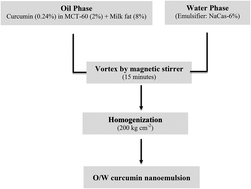Formulation and characterization of nanoencapsulated curcumin using sodium caseinate and its incorporation in ice cream
Abstract
In the present investigation, the preparation and characterization of a curcumin nanoemulsion with milk protein (sodium caseinate) and its incorporation into ice cream were undertaken. Among the different combinations, the most stable formulation was observed using milk fat (8%), medium chain triglycerides (2%), curcumin (0.24%) and sodium caseinate (6%) with a mean particle size of 333.8 ± 7.18 nm, a zeta potential of −44.1 ± 0.72 mV and an encapsulation efficiency of 96.9 ± 0.28%. The effect of different processing conditions (heating, pH and ionic strength) on the particle size distribution and zeta potential of the nanoemulsion was evaluated. During heat treatment, the particle size of the nanoemulsion was increased from 333.8 ± 7.18 to 351.1 ± 4.04 nm. The nanoemulsion was destabilized at pH 4.6 and the particle size increased above and below pH 5.0. However, there was a slight increase in the particle size with a change in the ionic concentration. The release kinetics data suggested that in simulated gastro-intestinal digestion, the nanoemulsion was stable against pepsin digestion (a 5.25% release of curcumin), while pancreatic action led to a 16.12% release of curcumin from the nanoemulsion. Finally, our formulation was successfully incorporated into ice cream and the sensory attributes were evaluated. No significant difference was observed in the scores of the sensory attributes between the control and ice cream prepared with a curcumin nanoemulsion. Moreover, the encapsulation efficiency of the curcumin incorporated into the ice cream was 93.7%, which indicates that it can withstand the processing conditions. The findings suggest that ice cream is a suitable dairy product for the delivery of lipophilic bioactive components (curcumin) which can be used for therapeutic purposes.


 Please wait while we load your content...
Please wait while we load your content...